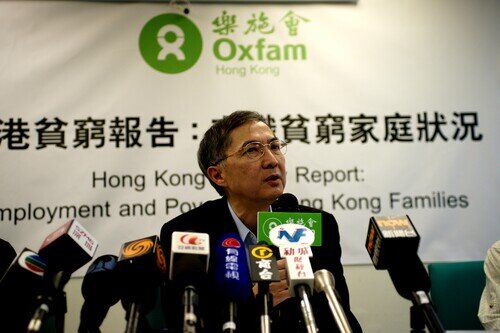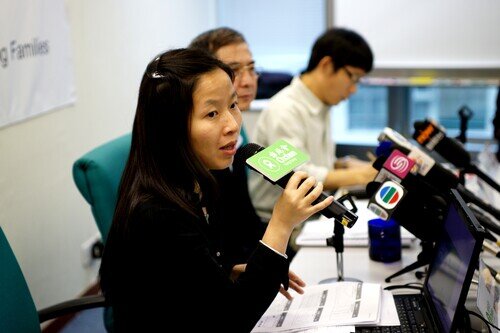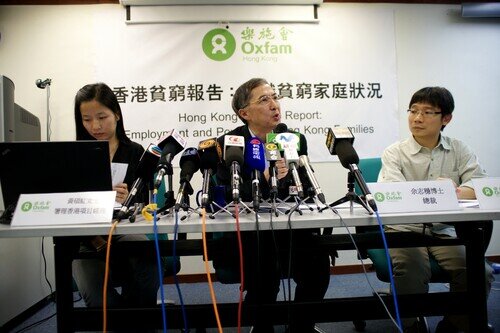13 NOV 2012
Record high of over 650,000 people living in working poor households, Oxfam calls for comprehensive income protection policies
Poverty among families of low-income workers has worsened in the last 10 years, according to Oxfam’s new report titled “Oxfam Hong Kong Poverty Report: Employment and Poverty in Hong Kong Families (2003-2012) ”. The report found that in the second quarter of 2012, the population living in working poor households reached 658,100, which is the highest record ever; and the wealth gap has also been widening during this period. Oxfam urges the government not only to review and adjust the level of minimum wage annually, but also to provide comprehensive income protection policies to improve the living standard of working poor families. In the long run, the feasibility of providing a Low Income Family Allowance should be explored as a supplementary provision to the minimum wage.
GENERAL POVERTY TRENDS
In the report, a “poor household” is defined as a household whose monthly income is less than 50% of the median income for all households of corresponding size.
- Over the past 10 years, the number of poor households in Hong Kong has remained at over 400,000, while the number of poor people has remained at more than 1,100,000, accounting for 20% of the total population. This corresponds to a poverty rate of about 17.6%. This means one in every six people in Hong Kong is living under the poverty line.
- In the second quarter of 2012, the median monthly household income of the richest 10% is 26.1 times that of the poorest 10%. This difference is larger than it was in 2003.
- The median monthly income of the poorest 10% households slightly increased from $3,000 in 2003 to $3,400 in the second quarter of 2012. Meanwhile, the median monthly income of the richest 10% households has increased almost 30%.
TRENDS AMONG THE WORKING POOR
In the report, a “working household” is defined as a household with at least one employed member (excluding foreign domestic helpers); a “working poor household” is defined as a household with at least one employed member (excluding foreign domestic helpers) and with a monthly household income less than 50% of the median income for all households of corresponding size.
- Increase in working poor households and population
In the second quarter of 2012, 10% (or 194,000 households) of all working households were poor. That is an 11.6% increase from 174,000 households in 2003. Working households with three or more members are more likely than smaller households to be poor. The total number of people living in these households has also increased from 608,900 to 658,100 during the same period. - Employed members of poor families bear heavier burdens
Over the past 10 years, among working poor households, the proportion of households with dependents aged six or below generally remains around 20%, and the proportion with dependents aged below 15 or aged 65 and above generally remains at 65%, which are much higher than those among all working households. Working poor households bear heavier burdens in terms of caring for dependents. On average, each employed member of these households must support TWO non-working members. However, among working families in general, each employed member only supports an average of 0.8 non-working members. - About 60% of the households of employed poor are living below CSSA level
In the second quarter of 2012, among 194,100 working poor families, 113,500 households with at least one worker had a monthly income of less than the average CSSA payment for a household of corresponding size. This situation describes nearly 60% (58.5%) of the total working poor households.
THE POPULATION AT RISK OF POVERTY
In the report, a “household at risk of poverty” is defined as a household whose monthly income is between 50% and 60% of the median income for all households of corresponding size; a “working household at risk of poverty” is defined as a household with at least one employed member (excluding foreign domestic helpers) and with an income equivalent to between 50% and 60% of the median income for households of corresponding size.
- About 190,000 households, or 470,000 persons, are at risk of poverty
In 2011 and the second quarter of 2012, there were respectively 618,000 and 642,500 households with a monthly income less than 60% of the median monthly income of all households of corresponding size. Excluding the poor households, there were 182,600 households (490,500 persons) and 191,500 households (477,700 persons) at risk of poverty. These account for 8% of all households. - About 120,000 working households, or 380,000 persons, are at risk of poverty
In 2011 and the second quarter of 2012, among all working households, there were respectively 300,700 and 313,000 households with incomes less than 60% of the median monthly income for households of corresponding size. Excluding the working poor households, there were 124,200 households (418,200 persons) and 118,900 households (387,100 persons) at risk of poverty. These account for 6.5% of all working households.
OXFAM HONG KONG RECOMMENDATIONS
The government has adopted a range of policies to alleviate pressure on working poor households and to help them meet their employment needs. However, these measures are insufficient and ineffective in combating the poverty faced by families of the working poor.
Oxfam Hong Kong maintains that all working people have the right to a decent minimum standard of living for themselves and their families. The implementation of a minimum wage may reduce the prevalence of poverty among the employed to a certain extent, but this measure alone may not be adequate to lift families out of poverty. In fact, 194,100 working households are still trapped in poverty. Oxfam believes a set of comprehensive policies is the key to helping working poor families out of poverty. Therefore, we recommend the Hong Kong Government to consider the following policy suggestions:
1. Poverty line and target of poverty alleviation
- The government is suggested to refer to the practice of The Organization for Economic Cooperation and Development (OECD), which defines poverty as an income at or less than 50% of the median income for households of corresponding size, and to closely monitor the households with incomes between 50% and 60% of the median income of households of corresponding size, as they are comparatively fragile and vulnerable to falling into poverty when the economy is weak. It is advisable to have policies that specifically target this group to strengthen their economic resilience.
- The government is also suggested to adopt Budget Standard Method to measure poverty. This can be done by identifying a basket of goods required to meet a household’s monthly needs and calculating the cost of the basket according to market prices. This total represents a standard household budget. Families whose income is less than the standard budget can be classified as poor households.
- Once a poverty line is determined, it is important to set specific poverty reduction targets, such as raising a certain number or percentage of working poor families out of poverty within a certain time frame. Moreover, continuous monitoring is necessary.
2. Review minimum wage
- The statutory minimum wage should be subject to annual review. The minimum wage should be adjusted annually for inflation, to ensure that the same level of purchasing power is maintained. The wage should ensure that full-time workers are paid more than the amount they would be entitled to under CSSA.
3. Explore the feasibility of Low Income Family Allowance
- The government is suggested to explore the feasibility of providing a Low Income Family Allowance for families that are considering applying for CSSA, those that are currently receiving low income CSSA but wish to leave the social security net, and those who refuse to apply for CSSA to avoid negative labeling. This could help relieve inter-generational poverty by providing families with more resources to meet their children’s educational needs.
4. Promote a positive public image of CSSA recipients
- The government should take positive steps to explain to the public the vital importance of low income CSSA, to encourage those whose earnings fall below subsistence level to make use of the system.
-End-
About Oxfam
Oxfam is dedicated to fighting poverty and inequity worldwide. The international and independent development and humanitarian organisation tackles poverty in four main ways: sustainable development in poor communities, disaster relief, local and global advocacy, and education with Hong Kong youth. Established in Hong Kong in 1976, Oxfam Hong Kong is a founding member of Oxfam, an international confederation that has assisted poor people in 94 countries. Oxfam Hong Kong alone has supported poor people in over 70 countries/regions.
For media enquiries, please contact:
| Shirley Chan Assistant Communications Officer Telephone: 3120-5281 Email: [email protected] | Wong Shek Hung Acting Hong Kong Programme Manager Telephone: 3120-5297 Email: [email protected] |

Stephen Fisher, Director General of Oxfam Hong Kong, said that in the second quarter of 2012, the median monthly household income of the richest 10% is 26.1 times that of the poorest 10%. He suggests the government to implement comprehensive social welfare and pro-poor polices in the long term.

“The increase in working poor population and the widening of the wealth gap reflects that current government policies are ineffective and inadequate,” said Wong Shek Hung, Acting Hong Kong Programme Manager.

Oxfam analysed the data from 2003 to 2012 of the Census and Statistics Department and found that the problem of employment poverty had worsened in the past 10 years.
